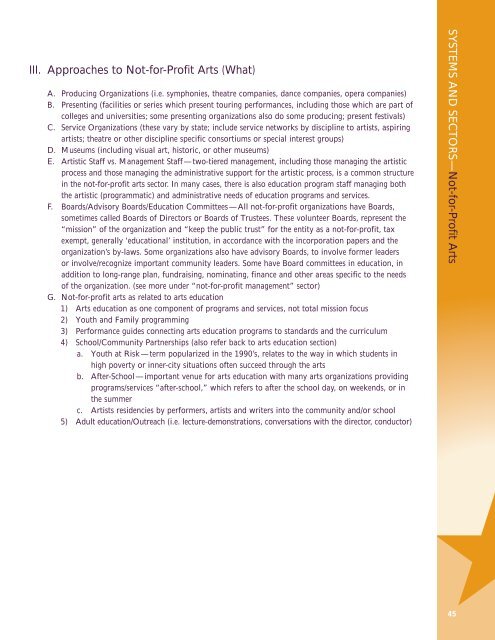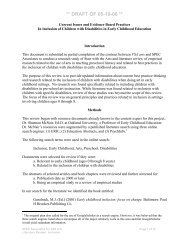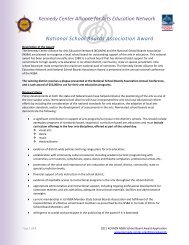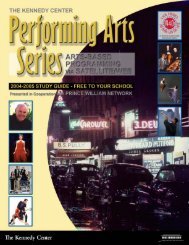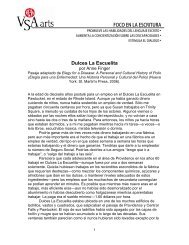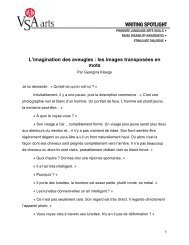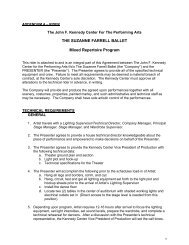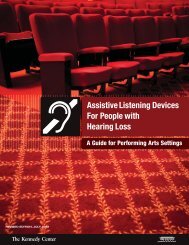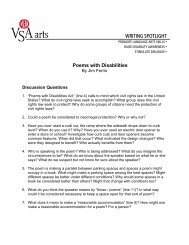KCAAEN Leadership Kit - The John F. Kennedy Center for the ...
KCAAEN Leadership Kit - The John F. Kennedy Center for the ...
KCAAEN Leadership Kit - The John F. Kennedy Center for the ...
Create successful ePaper yourself
Turn your PDF publications into a flip-book with our unique Google optimized e-Paper software.
III. Approaches to Not-<strong>for</strong>-Profit Arts (What)<br />
A. Producing Organizations (i.e. symphonies, <strong>the</strong>atre companies, dance companies, opera companies)<br />
B. Presenting (facilities or series which present touring per<strong>for</strong>mances, including those which are part of<br />
colleges and universities; some presenting organizations also do some producing; present festivals)<br />
C. Service Organizations (<strong>the</strong>se vary by state; include service networks by discipline to artists, aspiring<br />
artists; <strong>the</strong>atre or o<strong>the</strong>r discipline specific consortiums or special interest groups)<br />
D. Museums (including visual art, historic, or o<strong>the</strong>r museums)<br />
E. Artistic Staff vs. Management Staff—two-tiered management, including those managing <strong>the</strong> artistic<br />
process and those managing <strong>the</strong> administrative support <strong>for</strong> <strong>the</strong> artistic process, is a common structure<br />
in <strong>the</strong> not-<strong>for</strong>-profit arts sector. In many cases, <strong>the</strong>re is also education program staff managing both<br />
<strong>the</strong> artistic (programmatic) and administrative needs of education programs and services.<br />
F. Boards/Advisory Boards/Education Committees—All not-<strong>for</strong>-profit organizations have Boards,<br />
sometimes called Boards of Directors or Boards of Trustees. <strong>The</strong>se volunteer Boards, represent <strong>the</strong><br />
“mission” of <strong>the</strong> organization and “keep <strong>the</strong> public trust” <strong>for</strong> <strong>the</strong> entity as a not-<strong>for</strong>-profit, tax<br />
exempt, generally ‘educational’ institution, in accordance with <strong>the</strong> incorporation papers and <strong>the</strong><br />
organization’s by-laws. Some organizations also have advisory Boards, to involve <strong>for</strong>mer leaders<br />
or involve/recognize important community leaders. Some have Board committees in education, in<br />
addition to long-range plan, fundraising, nominating, finance and o<strong>the</strong>r areas specific to <strong>the</strong> needs<br />
of <strong>the</strong> organization. (see more under “not-<strong>for</strong>-profit management” sector)<br />
G. Not-<strong>for</strong>-profit arts as related to arts education<br />
1) Arts education as one component of programs and services, not total mission focus<br />
2) Youth and Family programming<br />
3) Per<strong>for</strong>mance guides connecting arts education programs to standards and <strong>the</strong> curriculum<br />
4) School/Community Partnerships (also refer back to arts education section)<br />
a. Youth at Risk—term popularized in <strong>the</strong> 1990’s, relates to <strong>the</strong> way in which students in<br />
high poverty or inner-city situations often succeed through <strong>the</strong> arts<br />
b. After-School—important venue <strong>for</strong> arts education with many arts organizations providing<br />
programs/services “after-school,” which refers to after <strong>the</strong> school day, on weekends, or in<br />
<strong>the</strong> summer<br />
c. Artists residencies by per<strong>for</strong>mers, artists and writers into <strong>the</strong> community and/or school<br />
5) Adult education/Outreach (i.e. lecture-demonstrations, conversations with <strong>the</strong> director, conductor)<br />
SYSTEMS AND SECTORS—Not-<strong>for</strong>-Profit Arts<br />
45


